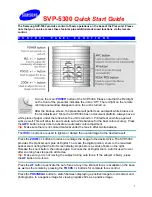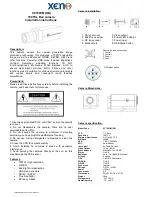
60
Operational Reference
Genie Color Series-GigE Vision Camera
LUT Control via Sapera LT or GigE Vision Compliant Applications
Sapera
Genie Sapera parameters for LUT control:
LUTEnable
= {FALSE, TRUE}
LUTFormat
= {RGB }
LUTNumberEntries
= Number of entries in the LUT (256 for an 8-bit LUT)
LUTData
= Array of data representing the LUT content
+ classes used:
SapLut Class implements LUT management.
BOOL SapAcqDevice::SetFeatureValue(const char *featureName, SapLut *featureLut)
BOOL SapAcqDevice::SetFeatureValue(int featureIndex, SapLut *featureLut)
BOOL SapAcqDevice::GetFeatureValue(const char *featureName, SapLut *featureLut)
BOOL SapAcqDevice::GetFeatureValue(int featureIndex, SapLut *featureLut)
In CamExpert, these features are available from the “Pre-Processing” menu.
XML features for LUT control:
LUTSelector = Select the LUT to control { Luminance=0 }
LUTEnable = Enable the selected LUT { False, True }
LUTIndex = LUT data index { 0 to 255 for 8-bit LUT, 0 to 1023 for a 10-bit LUT }
LUTValue = Value of selected LUT element at index LutIndex.
Flat Field (Image Shading) Correction
Image Shading correction, also known as Flat Field Correction is the process of eliminating small gain differences
between pixels in a sensor, eliminate sensor hotspots by automatically doing pixel replacement, and also to
compensate for light distortion caused by a lens. That sensor when exposed to a uniformly lit field will have no gray
level differences between pixels when calibrated flat field correction is applied to the image. The Genie camera
stores flat field correction data until power off or in its user setting state for recall at any time (see
"
Power-up
Configuration
" on page 32
). Flat field correction data is composed of 8 bit gain and 8 bit offset coefficients.
The CamExpert Flat Field Correction tool (or Sapera Flat Field Demo) allows calibrating. saving, and loading the
flat field calibration data for any Genie camera being controlled.
Information on the Flat Field Data File
A Sapera application (such as CamExpert) creates a new SapBuffer object of the same width as the image buffer but
with twice the number of lines. This provides the room to store both offset and gain Flat Field data. The Flat Field
offset data is contained in the top half of the new buffer, while the gain buffer is in the bottom half.
A Sapera application saves the new buffer using SapBuffer::Save with the "-format tiff" option, which allows
saving both 8-bit and 10-bit offset/gain data without loss of significant bits.
The Flat Field correction formula is:
correctedPixelValue = (originalPixelValue - offset) * (gain/128)
Note: If the offset data = 0xff, then that is a special flag, indicating that the pixel is replaced with an adjacent pixel,
without any calculation. The Flat Field calibration procedure using Sapera tools as described in this section, will
eliminate dead or hot pixels. With color sensors, this algorithm automatically selects the replacement pixel of the
same color. A pixel on the left edge (beginning of the line) would be replaced with the pixel to its right, while a
pixel on the right edge (end of the line) is replaced with the pixel to its left. Any pixel within a line is replaced with
the average of the its neighboring pixels (on the same line).
















































